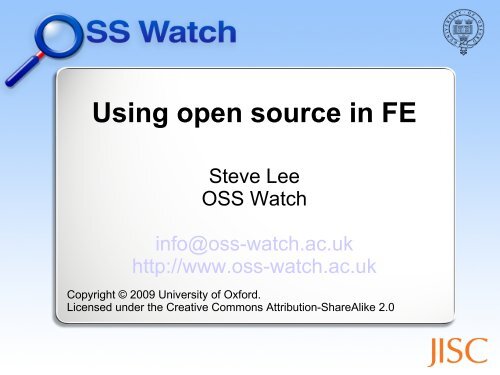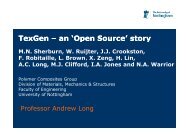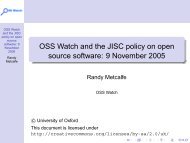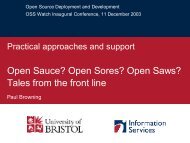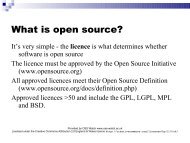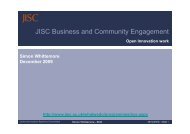Using open source in FE - OSS Watch
Using open source in FE - OSS Watch
Using open source in FE - OSS Watch
You also want an ePaper? Increase the reach of your titles
YUMPU automatically turns print PDFs into web optimized ePapers that Google loves.
<strong>Us<strong>in</strong>g</strong> <strong>open</strong> <strong>source</strong> <strong>in</strong> <strong>FE</strong><br />
Steve Lee<br />
<strong>OSS</strong> <strong>Watch</strong><br />
<strong>in</strong>fo@oss-watch.ac.uk<br />
http://www.oss-watch.ac.uk<br />
Copyright © 2009 University of Oxford.<br />
Licensed under the Creative Commons Attribution-ShareAlike 2.0
<strong>OSS</strong> <strong>Watch</strong><br />
<br />
Open <strong>source</strong> advisory service<br />
−<br />
−<br />
−<br />
Non-Advocacy<br />
Procurement, engagement, development, legal<br />
Consultancy, events, community development<br />
Publications and surveys<br />
<br />
Free of charge to <strong>FE</strong> and HE
It starts with a licence...<br />
<br />
<br />
Software released under an OSI approved<br />
licence<br />
In practice, approx. same as free software<br />
(FSF)
Open <strong>source</strong> def<strong>in</strong>ition<br />
• Free redistribution<br />
• Source code<br />
• Derived works<br />
• Integrity of author's work<br />
• No discrim<strong>in</strong>ation aga<strong>in</strong>st persons or groups<br />
• http://www.<strong>open</strong><strong>source</strong>.org/docs/def<strong>in</strong>ition.php
But it's much more than a<br />
licence...<br />
• “The real value of <strong>open</strong> <strong>source</strong><br />
software is that it allows communities<br />
to work together and solve problems”<br />
[7] I. Wladawsky-Berger,IBM<br />
• Susta<strong>in</strong>able communities<br />
• Open formats and standards<br />
• Open development
Project Community
Some myths (1)<br />
<br />
<br />
Myth<br />
<br />
<br />
Facts<br />
<br />
<br />
<br />
Anarchic projects managed by volunteers<br />
“Sandals and woolly hats”<br />
L<strong>in</strong>ux Foundation board: Novell, Oracle, Fujitsu,<br />
Intel, IBM, Hitachi, HP, AMD, NEC, Texas<br />
Instruments, Motorola<br />
Sun: 34+ projects. Mozilla: AOL, Google<br />
UK Open <strong>source</strong> consortium: 56 members
Some myths (2)<br />
<br />
<br />
Myth<br />
<br />
Facts<br />
<br />
<br />
Free (as <strong>in</strong> free beer)<br />
Costs: staff, support, tra<strong>in</strong><strong>in</strong>g...<br />
50% companies deploy<strong>in</strong>g more than 25 <strong>open</strong> <strong>source</strong><br />
products, > 20% sav<strong>in</strong>gs <strong>in</strong> IT budget [1] InfoWorld<br />
<br />
1% companies costs went up [1]
Some myths (3)<br />
Myth<br />
<br />
Facts<br />
You can't generate <strong>in</strong>come from <strong>OSS</strong><br />
<br />
Worldwide revenue $1.8bn <strong>in</strong> 2006<br />
ris<strong>in</strong>g to $5.8bn <strong>in</strong> 2011 [5] IDC report
Some myths (4)<br />
Myth<br />
<br />
Facts<br />
You have to engage with the project if<br />
you use <strong>open</strong> <strong>source</strong><br />
<br />
You can out<strong>source</strong> all support and<br />
development services if you want to
<strong>OSS</strong> always right (1)<br />
<br />
No<br />
<br />
Consider <strong>open</strong> <strong>source</strong> alongside closed <strong>source</strong> and<br />
make an <strong>in</strong>formed decision<br />
Some key pitfalls with <strong>open</strong> <strong>source</strong><br />
<br />
<br />
You need the right person or company to adm<strong>in</strong>ister and<br />
support it<br />
Open <strong>source</strong> projects sometimes lack support<br />
mechanisms and/or re<strong>source</strong>s (docs, communities, etc.)
<strong>OSS</strong> always right (2)<br />
<br />
Sometimes <strong>open</strong> <strong>source</strong> is just a<br />
market<strong>in</strong>g tool<br />
<br />
<br />
Restricted <strong>open</strong> <strong>source</strong> version, all<br />
features <strong>in</strong> closed <strong>source</strong> version<br />
Closed development methodology
Why Official Guidel<strong>in</strong>es<br />
<br />
<br />
<br />
UK Government will consider <strong>OSS</strong> solutions alongside<br />
proprietary ones <strong>in</strong> IT procurements. Contracts will be awarded on<br />
a value for money basis [2]<br />
The [EC] will consider <strong>OSS</strong> solutions the same way as proprietary<br />
ones <strong>in</strong> IT procurements. Contracts will be awarded on a value for<br />
money basis [3]<br />
JISC-funded projects must not discrim<strong>in</strong>ate between <strong>open</strong> <strong>source</strong><br />
and closed <strong>source</strong> software, unless the purpose of the projects or<br />
services specifically requires it [4]
Market reality<br />
• “Open <strong>source</strong> is the most significant allencompass<strong>in</strong>g<br />
and long-term trend that<br />
the software <strong>in</strong>dustry has seen s<strong>in</strong>ce<br />
the early 1980s” [5] IDC report<br />
• "By 2012, more than 90 percent of<br />
enterprises will use <strong>open</strong> <strong>source</strong> <strong>in</strong><br />
direct or embedded forms" [6] Gartner<br />
report
Your Enterprise Needs<br />
• Manag<strong>in</strong>g risk<br />
• Flexibility<br />
• Interoperability & <strong>in</strong>tegration<br />
• Avoidance of lock-<strong>in</strong><br />
• Viable alternatives
Open Source <strong>in</strong> HE and <strong>FE</strong><br />
<br />
National survey 2008<br />
<br />
<br />
<br />
<br />
ICT Directors from UK HE and <strong>FE</strong><br />
<strong>in</strong>stitutions<br />
454 <strong>FE</strong>/<strong>FE</strong>+HE<br />
161 HE<br />
19% response rate
Limited re<strong>source</strong>s <strong>in</strong> <strong>FE</strong><br />
• Typical <strong>FE</strong> ICT departments employ<br />
between 7 and 10 staff<br />
• 7 times larger <strong>in</strong> HE<br />
• <strong>FE</strong> staff lower technical qualifications on<br />
average<br />
• Traditionally, <strong>FE</strong> less <strong>open</strong> <strong>source</strong> friendly<br />
than HE, but now you are catch<strong>in</strong>g up
Policy and Practice<br />
<br />
Policy<br />
<br />
In 2006, 30% <strong>in</strong>stitutions mentioned <strong>open</strong> <strong>source</strong><br />
<br />
In 2008, 57%<br />
<br />
Staff contributions regulated <strong>in</strong> only 14%<br />
<br />
Practice<br />
<br />
<br />
In 2006, 77% considered <strong>open</strong> <strong>source</strong><br />
In 2008, 87% (but only 15% equally to closed<br />
<strong>source</strong>)
Servers <strong>in</strong>creas<strong>in</strong>gly <strong>open</strong><br />
<br />
All or almost all closed <strong>source</strong><br />
<br />
Reduc<strong>in</strong>g from 56% (2006) to 40% (2008)<br />
<br />
Mostly closed <strong>source</strong><br />
<br />
Increas<strong>in</strong>g from 20% (2006) to 44% (2008)<br />
<br />
<br />
Half <strong>open</strong> and half closed <strong>source</strong><br />
<br />
Increas<strong>in</strong>g from 3% (2008) to 11% (future)<br />
Similar trend on desktops
Criteria for procurement <strong>in</strong><br />
<strong>FE</strong><br />
<br />
<br />
Top criteria<br />
<br />
<br />
Performance, <strong>in</strong>teroperability with other products,<br />
familiarity and TCO (servers)<br />
Performance and avoid lock-<strong>in</strong>s, TCO (desktops)<br />
Bottom criteria<br />
<br />
<br />
Ideological reasons and migration costs (servers)<br />
Migration costs and legal issues (desktops)
Reasons to reject <strong>OSS</strong> given<br />
by <strong>FE</strong><br />
<br />
<br />
Top reasons on servers<br />
<br />
<br />
Lack of staff expertise and support<br />
Poor quality<br />
Top reasons on desktops<br />
<br />
<br />
<br />
<br />
Not what users want<br />
Lack of staff expertise<br />
No solution for our need<br />
Lack of support
What is needed <strong>in</strong> tenders<br />
<br />
<br />
<br />
Focus on user needs not products or<br />
technology<br />
Recognise customisation is always<br />
needed<br />
Recognise the value of reuse through<br />
collaboration
What is needed for<br />
adoption<br />
<br />
<br />
<br />
Understand the <strong>open</strong> <strong>source</strong><br />
development model<br />
Engage with the <strong>OSS</strong> development<br />
model (not mean just programm<strong>in</strong>g)<br />
Become aware of professional and true<br />
<strong>open</strong> <strong>source</strong> companies
Conclusions<br />
<br />
<br />
<br />
<br />
<br />
<strong>OSS</strong> <strong>Watch</strong> is here to help you <strong>in</strong>fo@oss-watch.ac.uk<br />
Open <strong>source</strong> starts with a licence, but works thanks to the<br />
community and development practices.<br />
System <strong>in</strong>tegrators play an important role<br />
Volunteers, small and big bus<strong>in</strong>esses... but are they reach<strong>in</strong>g<br />
<strong>FE</strong><br />
Trend is clearly towards more <strong>open</strong> <strong>source</strong>


